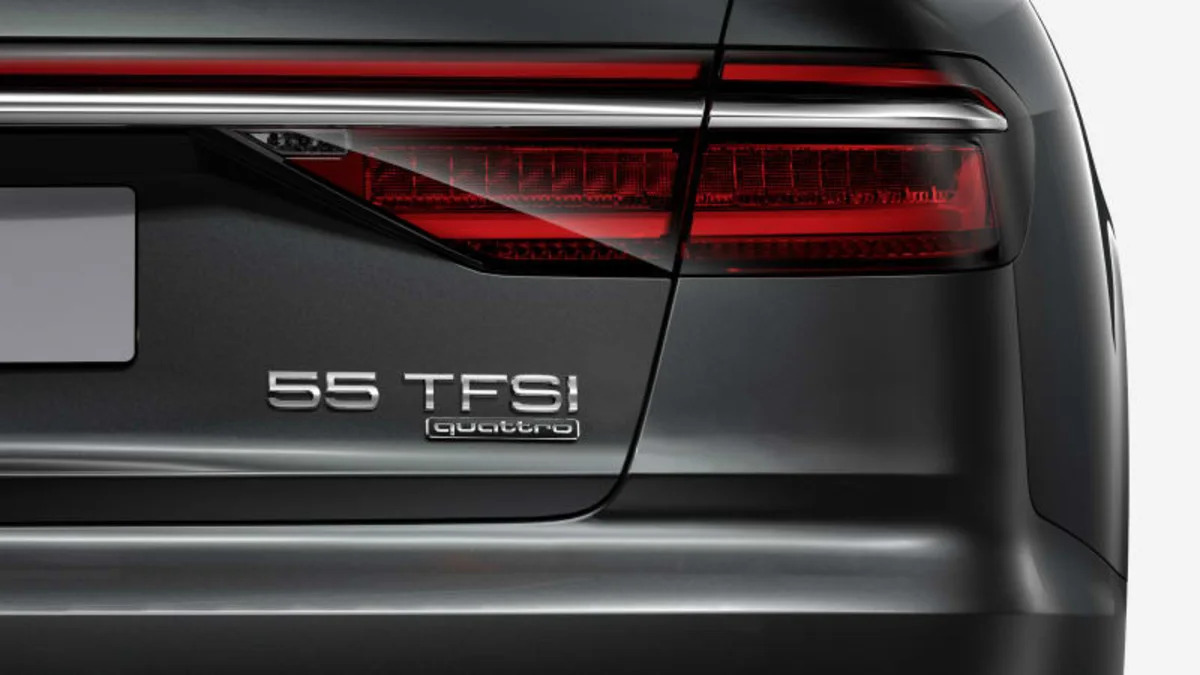Once upon a time, model numbers indicated a car's engine displacement. A BMW 328i had a 2.8-liter engine, a Mercedes S500 had a 5.0-liter V8, etc. Then engine downsizing happened. Since a new car couldn't have a lower and thus seemingly inferior number than its predecessor, we ended up with model numbers that represented nothing but an incremental trip up the heirarchy. Perhaps it makes no difference to consumers, but Audi has announced that it's going to bring order to chaos with a new name/badging system for the 2018 model year.
Here's how it works. Current model names (A4, Q5, etc.) will remain the same, but their engine designations (2.0T, 3.0T, etc) will switch to a two-digit number that represents the car's horsepower (or kilowatts as Audi used in the announcement) regardless of whether it runs on gasoline, diesel, electricity or a combination of fuels.
The numbering starts at 30, which Audi explains represents engines making 110 to 131 horsepower. The other example Audi gives is 45, which represents cars making 230 to 252 hp. At the top of the range is 70, which is for cars that make over 544 hp. As an example, our 252-horsepower Audi A4 Allroad long-term car would have a 45 appended to its hatch-mounted "allroad" badge along with TFSI to denote that it's powered by gasoline.
It's not a consistent system, though. The range of power covered by each number isn't consistent, and there are some gaps, as shown by Autocar's complete breakdown of the numbering scheme using British brake horsepower. For instance, the 40 range covers cars between 170 and 203 of our horsepower, a difference of about 30 hp compared with a difference of about 20 hp for the 45 range. This also means that there isn't a new number for cars making between 204 and 229 hp. Even though Audi may not currently have engines in the gap zones, it seems like expanding each group to fill the gaps would be a useful way to future-proof the system for new engines.
Despite this, we appreciate Audi's attempt to bring meaning to badging again. There's also another good reason for the system. It provides a unified way of ranking powertrains instead of displacement, which isn't necessarily accurate at conveying performance between gas and diesel engines, and is irrelevant for electric and electrified powertrains.
As Dr. Dietmar Voggenreiter, board of management member for sales and marketing at AUDI AG, puts it, "As alternative drive technologies become increasingly relevant, engine displacement as a performance attribute is becoming less important to our customers. The clarity and logic of structuring the designations according to power output makes it possible to distinguish between the various performance levels."
However, before you start memorizing future names and numbers, there's a chance they won't even be making it to the United States. While an Audi representative in Germany told us that the new naming strategy was global and that it would indeed be coming here, a representative in the United States indicated that it had not been confirmed. Such confusion is not unusual, however, and we expect a definitive answer in the near future as corporate wires become uncrossed.
Related Video:
Here's how it works. Current model names (A4, Q5, etc.) will remain the same, but their engine designations (2.0T, 3.0T, etc) will switch to a two-digit number that represents the car's horsepower (or kilowatts as Audi used in the announcement) regardless of whether it runs on gasoline, diesel, electricity or a combination of fuels.
The numbering starts at 30, which Audi explains represents engines making 110 to 131 horsepower. The other example Audi gives is 45, which represents cars making 230 to 252 hp. At the top of the range is 70, which is for cars that make over 544 hp. As an example, our 252-horsepower Audi A4 Allroad long-term car would have a 45 appended to its hatch-mounted "allroad" badge along with TFSI to denote that it's powered by gasoline.
It's not a consistent system, though. The range of power covered by each number isn't consistent, and there are some gaps, as shown by Autocar's complete breakdown of the numbering scheme using British brake horsepower. For instance, the 40 range covers cars between 170 and 203 of our horsepower, a difference of about 30 hp compared with a difference of about 20 hp for the 45 range. This also means that there isn't a new number for cars making between 204 and 229 hp. Even though Audi may not currently have engines in the gap zones, it seems like expanding each group to fill the gaps would be a useful way to future-proof the system for new engines.
Despite this, we appreciate Audi's attempt to bring meaning to badging again. There's also another good reason for the system. It provides a unified way of ranking powertrains instead of displacement, which isn't necessarily accurate at conveying performance between gas and diesel engines, and is irrelevant for electric and electrified powertrains.
As Dr. Dietmar Voggenreiter, board of management member for sales and marketing at AUDI AG, puts it, "As alternative drive technologies become increasingly relevant, engine displacement as a performance attribute is becoming less important to our customers. The clarity and logic of structuring the designations according to power output makes it possible to distinguish between the various performance levels."
However, before you start memorizing future names and numbers, there's a chance they won't even be making it to the United States. While an Audi representative in Germany told us that the new naming strategy was global and that it would indeed be coming here, a representative in the United States indicated that it had not been confirmed. Such confusion is not unusual, however, and we expect a definitive answer in the near future as corporate wires become uncrossed.
Related Video:


Sign in to post
Please sign in to leave a comment.
Continue